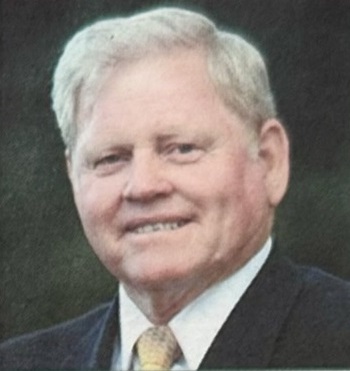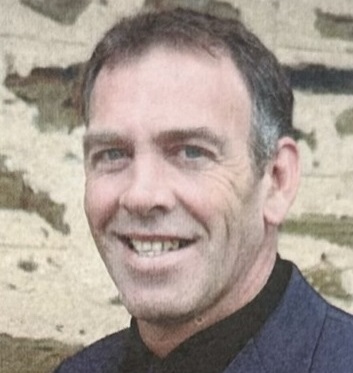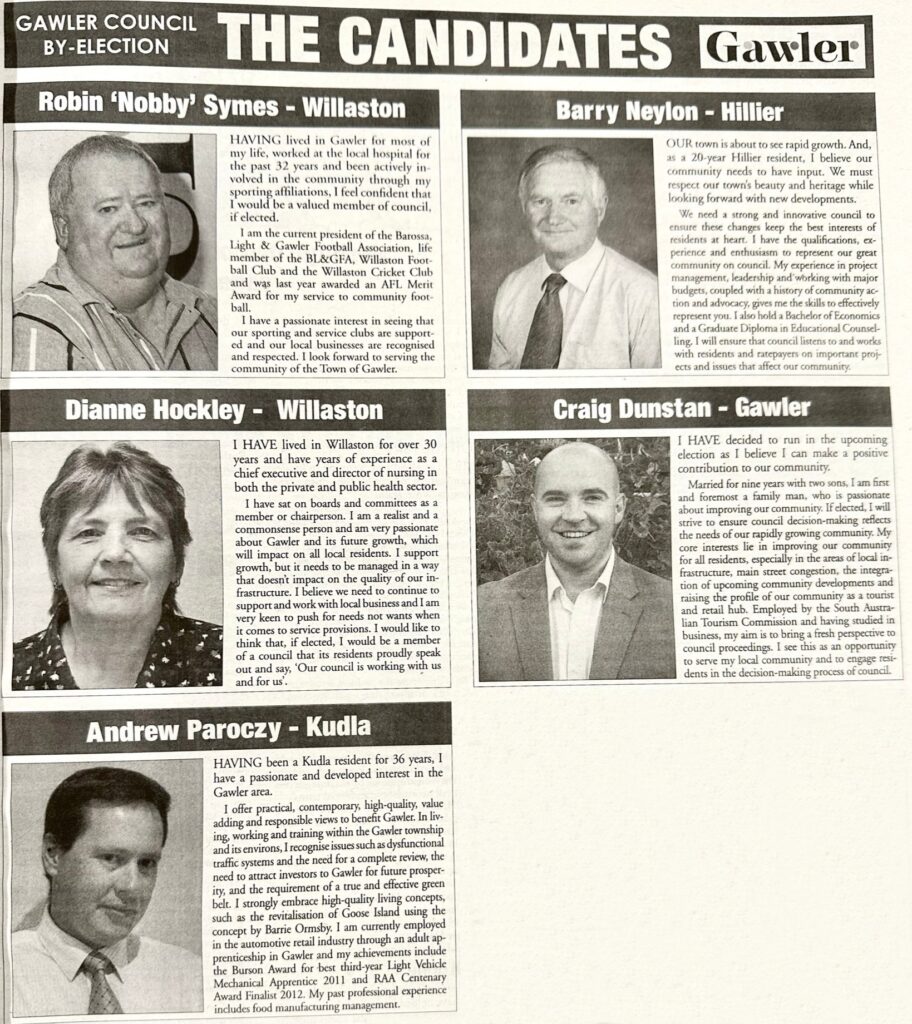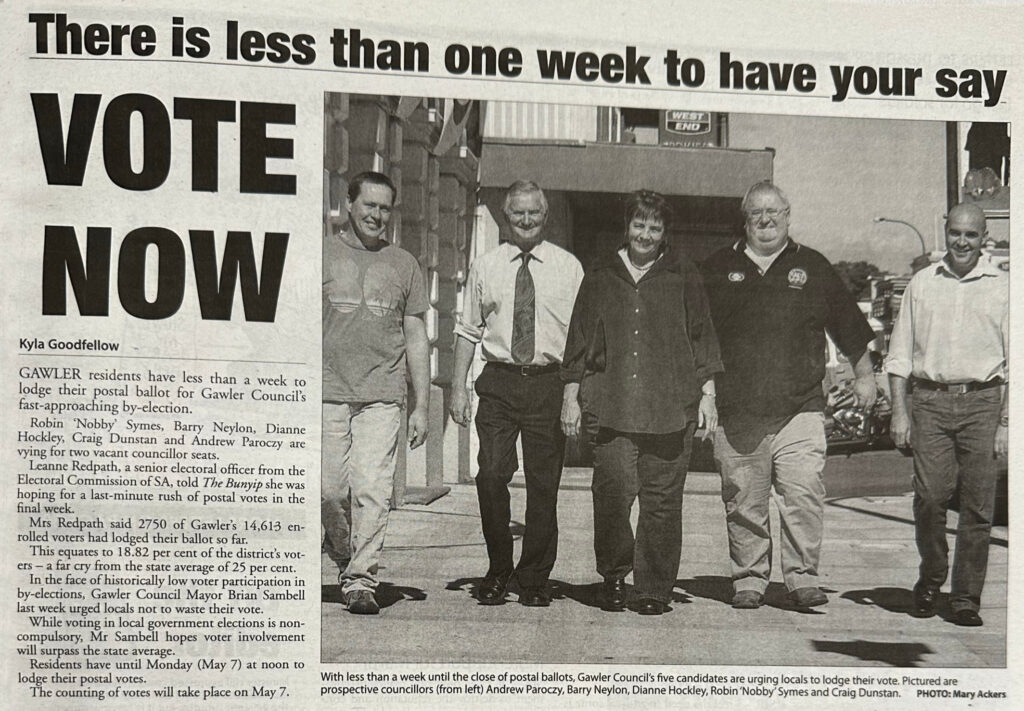We now reach November of 2010; Brian Sambell has just completed his first term as Mayor of Gawler, and he’s all ready for a second one. First, though, he’ll have to compete with four other challengers for the position.
Let’s meet them now.
Meet the Mayoral candidates
Here are our five candidates, listed in ballot order:

Brian Sambell
The incumbent Mayor of Gawler, 2006-2010. Before his time on Council, he was well-known around town as the head of Gawler’s tourism authority.

Shaun Moylan
A newcomer to the Council scene; I can’t find too much detail beyond his own candidate profile as it seems like this was the only time he ran for office. At the time of the election, he held a senior position at Steinborner Holden in Gawler.

Warren Dibben
An incumbent Councillor, he had been on the Gawler Council for 11 years, from 1993-1997 and then again from 2003-2010. Briefly served as Deputy Mayor in 2003. President of the Rotary Club of Gawler.

Peter Russell
An incumbent first-term Councillor, he had just finished his 2006-2010 term when he decided to run for Mayor instead. His wife, Karen Carmody, is also in the running for a Councillor position this time around.

John Bolton
If you’ve been following along with my posts so far you would already be familiar with him in his now third appearance, but to voters, this would be their first time seeing him on the ballot. A local lawyer in the town.

The Bunyip, September 1st, 2010
As a side note, around this time period, The Bunyip was very enthusiastic about trying to get candidates to all stand or walk together in a single line for a photo. Be on the lookout for more of that as we continue.
Mayoral results


As you can see, Brian Sambell has been re-elected to a second four-term term, from 2010-2014.
Unfortunately, this is the point in time at which I can no longer find the detailed preference flow results for Gawler elections. The Electoral Commission doesn’t keep them on their website for very long after an election and the reason I had the 2014/2018/2022 results is because I was a candidate in all those elections. If anyone has older preference flow documents, I would really appreciate being able to add that information to the database.
That said, we do have enough information from the image above to get a general picture of what happened. I don’t believe I’ve explained the results column labelled “Count” before; it basically refers to how many times the Electoral Commission have re-distributed votes. On the first count, they count the first preference votes and see if anyone’s won yet, and then if not, they move on to the second count where they eliminate someone and then see if anyone’s won yet, and so on and so forth.
So, based on the order of these counts, we can assume that this is the order in which the candidates finished:
1st: Brian Sambell
2nd: John Bolton
3rd: Warren Dibben
4th: Peter Russell
5th: Shaun Moylan
We also know that the vote count ended up like this:
46% of the final vote: Brian Sambell (7% gained through preferences), winner
40% of the final vote: John Bolton (9% gained through preferences)
14% of the final vote: Moylan, Dibben and Russell voters who didn’t list a preference between Sambell and Bolton.
That’s a good amount of information we still have without access to the preference flows document. We know that, like in 2022, a winner was reached without anyone hitting the quota (due to the number of candidates). However, unlike 2022, the preferences of the other candidates were fairly evenly split.
The information we’ve lost, though, is the individual preferences of Moylan, Dibben and Russell voters. Hopefully, it’s still being archived somewhere!
The Councillor election

A profile of each Councillor candidate, courtesy of The Bunyip Newspaper, October 27th 2010.
Looking at this list of candidates, you may see a few familiar faces. This is the first election of several Elected Members who are still around in 2022. Karen Redman, who will become Mayor four years later, is running for Council for the first time here. David Hughes and Paul Koch, both still on Council in 2022, are also making their debut in 2010.
Of the 2010 Councillor candidates, only three were incumbent Councillors. While Brian Thom, Adrian Shackley and David Strauss did run again, they were the only ones; Warren Dibben and Peter Russell ran for Mayor instead and were out of contention for Councillor positions, and first-time Councillors Penny Johnston, Tom Zorich, Gregory Morris, and Patricia Dent had all declined to run again.
Worth a special mention here is Lillian Bartlett, whose retirement in 2010 came after 17 consecutive years on Gawler Council; she had been in since 1993.
Here are the results:

The winners, in order of their election, are:
- Brian Thom (incumbent) – winner of this election’s “top of the ballot bonus”, but also a prominent figure who had spent the past four years as Deputy Mayor. The combination of those two things seems to have given him a ridiculously large two-and-a-half quotas, which is the biggest Gawler Councillor result I’ve ever seen.
- David Strauss (incumbent) – Also got a quota and a half; he would have been riding off high name recognition due to competing in the federal election three months earlier. More on that later.
- Scott Fraser (returning but not incumbent) – notably, elected to Council together with his wife Diane this time. In fact, they campaigned as a team.
- Karen Carmody (new)
- Karen Redman (new)
- Kevin Fischer (returning but not incumbent)
- Diane Fraser (new)
- Patricia Dent (new)
- Penny Johnston (new)
- Adrian Shackley (incumbent)
This was in some ways a pretty huge turnover – seven elected members had changed since the last Council. That said, all three incumbents who ran were re-elected, so in that specific sense there hadn’t been any turnover at all.
Usually, this would be the end of the 2010-2014 election story for the purposes of my blog, except that halfway through the term there was a change of Councillors due to the calling of a by-election.
The 2012 by-election trigger

The Bunyip Newspaper, February 1st 2012.
David Strauss was in his third term as a Gawler elected member by the time of his resignation. He had been a Gawler Councillor since 2003 (with previous experience as a Councillor in both the Munno Para and Playford councils), and in 2010 had even contested the federal election, which was held only three months before the Council elections. His run (representing the Liberal Party) against sitting Labor MP Nick Champion in the local federal seat of Wakefield was ultimately unsuccessful, but could only have been a boost for his name recognition back in Gawler.
This resignation was for a simple enough reason – he and his wife were moving to Melbourne. This would not have triggered a by-election on its own, except that another Councillor, Karen Carmody, had already resigned less than a year into her first term. She had refused to comment to The Bunyip on why, but her husband, unsuccessful mayoral candidate Peter Russell, cited her frustration with Council bureaucracy.
Meet the Candidates
After the by-election was announced, five people applied for the two open positions. Here are their profiles:

The Bunyip, April 12th 2012.
Of these candidates, only one, Dianne Hockley, had previously run in the 2010 elections.
Turnout was low for this election – only 3601 ballot papers were lodged, a major fall compared to the 4947 who had done the same during the 2010 election. That’s not a reflection of this particular election, though, so much as just the nature of by-elections. After all, there’s less at stake, fewer people running, and no mayoral race (which tends to enthuse voters).

The Bunyip, May 2nd 2012
Here we see the photographer at The Bunyip making all the candidates walk together in a line for a photoshoot again. A classic technique; don’t know why they ever gave it up.
The Results


Dianne Hockley, who ran unsuccessfully in 2010, was finally a Councillor. Barry Neylon, a first-time candidate, had also been elected. Of the three other candidates, two haven’t run again since, but it’s worth noting that Nobby Symes, who took third place here, went on to win two years later in the 2014 Council elections.
Unfortunately, I don’t have any result information other than the official Electoral Commission result listed above. That means I don’t know whether either candidate hit quota in the end, or how many votes they had at the final tally.
Here’s an official group photo of the new 2010 Council after the 2012 by-election:

Meanwhile, in Boundary Reform
I wanted to create this little section because this is still a very topical issue in Gawler, and it’s always interesting to see it appear over and over in some form throughout its history. In some ways, this is the very oldest Gawler Council topic there is; in 1857, the Town of Gawler was formed because the local residents, who were split between several regional Councils, were complaining about the need for better Council boundaries.
My Council elections research is well ahead of my actual blog posting (I’m back to Bunyip Newspapers from the mid-90s so far) and so far in my research, the boundary discussion has continued to reappear; I’ve already seen at least three different Gawler boundary reform proposals between 1995 and now.
This 2010 Bunyip survey, thirteen years ago as of the time of posting, shows that the question of Hewett being in a different Council area to Gawler (currently a hot topic) was still an active political issue even at the time.

The Bunyip, November 3rd 2010.
Then, while I was reading through the 2012 editions of The Bunyip in search of news about the by-election, I came across this article (written on the same day as the by-election results).

The Bunyip, May 9th 2012.
Here he is again – perpetual mayoral candidate and (at the time) Concordia resident John Bolton, here with a plan for Council boundary reform. It addresses both the suburb of Hewett and its neighbouring Concordia.
According to the article, Mayor Brian Sambell ‘applauded’ the proposal, stating that Gawler would benefit significantly from boundary change and that “As we go forward into the future, a little bit of amalgamation or an extended boundary has got to be the way to go”. He certainly wasn’t the first Gawler Mayor to say so; as we go further into the past we’ll hear other proposals on reforming our current-day boundaries (in place since 1985) be endorsed by Mayor Tony Piccolo as well as Mayor Bruce Eastick.
I’m not here to debate the merits of the actual boundary reform proposals; even if an idea is common-sense in theory, the problem has always been that trying to achieve it in practice involves a lot of complicated questions about finance that need to be sorted out first. But I did think it was worth bringing up here, as it certainly won’t be the last time that a Council boundary debate is politically relevant as we continue our journey back into Gawler’s past.
Pingback: 1993 in Gawler's Election History - Cody Davies - Town of Gawler Elected Member